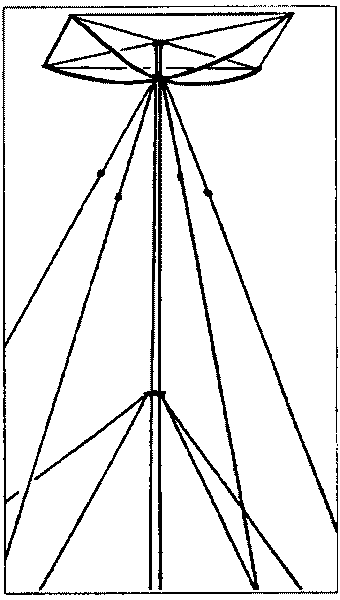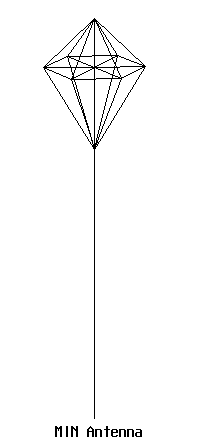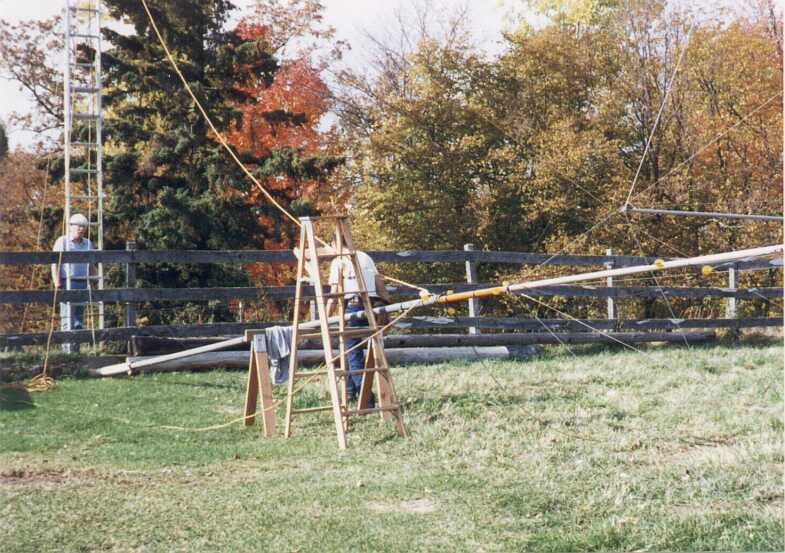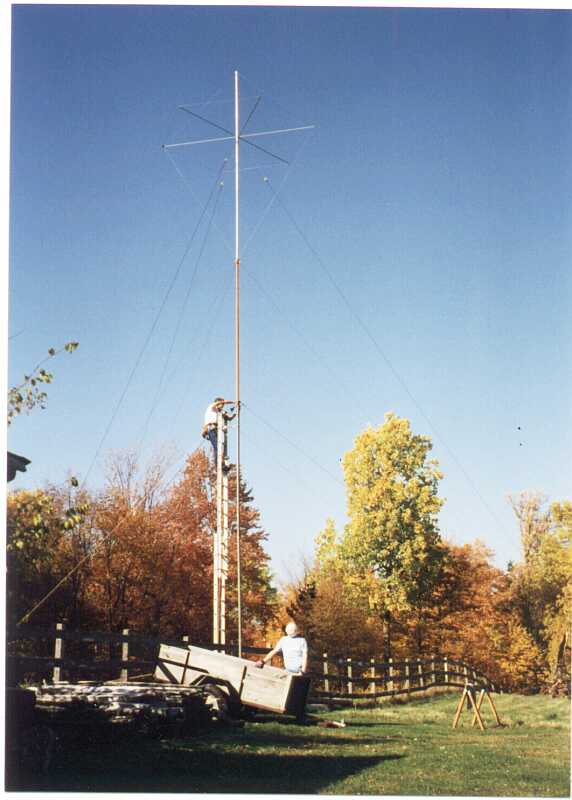"Lightweight" LowFER Verticals
As anyone knows who has tried it, erecting a tall, flimsy mast with a large top hat presents quite an engineering challenge. Here is a description of two LowFER vertical antennas that are relatively lightweight and easy to erect, but rugged enough to survive at least a moderate ice or wind storm. Neither of these antennas is in operation today, but they were taken down by the beacon operators, not by Mother Nature. And while they were up, they performed quite well. Both BK (Shell Lake, WI) and MIN (Aitkin, MN) were copied in real-time CW mode (12 WPM) as far away as Illinois and Ohio. In the days prior to ultra-slow-speed CW and all-night computer captures, reception of a LowFER beacon at 600 or 700 miles was rare DX. And BK was not just heard in Ohio; he had a solid two-way CW QSO -- something that is not even considered these days!
A sketch of BK's "old" antenna is shown here. It was mounted on the roof of a storage shed, which put the base of the mast about 10 feet above ground. The top hat, as described by Bruce in the February, 1996 LOWDOWN, was made by bowing 5/16" aluminum tubing into what look like bows and bowstrings attached to the mast, with an aluminum skirt wire. The skirt wire formed a square roughly 10' X 10'. As I recall, the mast itself was made from two 16-foot fiberglass windsurfer masts stuck one on top of the other, with a piece of aluminum tubing slid over the top to give an overall height above ground of about 42 feet. The whole structure was pretty light and could be erected easily by three people. Actually, once the lengths of the guy ropes were determined so that the antenna wouldn't tilt beyond vertical, two people could raise it.

BK's old antenna
When the level of Shell Lake rose so high that it threatened to float Bruce's cabin away, the cabin, shed, and everything else had to be moved to higher ground. In the process, Bruce erected a free-standing 40 foot aluminum tower with an HF triband beam. He was able to isolate the beam from the grounded tower, and use it quite successfully as a LowFER antenna, as described in my "Listening for LowFERs - Part 2" article.
In the Fall of 1997, I put up a temporary LowFER antenna in an open area behind my barn, about 150 feet from my primary "LEK flat top". This beacon operated with the identifier "MIN". The mast was made from odds and ends of stuff that I had in my collection of antenna building materials. At the very bottom there was about 30 inches of 3" PVC pipe; then 20 feet of 2" heavy wall electrical conduit, followed by a 16-foot fiberglass windsurfer mast that telescoped inside the conduit. At the top was a 14 foot length of 2", fairly thin wall aluminum tubing which slid over the tapered end of the windsurfer mast. A #12 copper wire connected the top section to the conduit at the bottom to bridge the non-conducting windsurfer mast. The overall length of the mast was 49 feet when fully extended, but by sliding the windsurfer mast inside the conduit, the length could be reduced by at least 10 feet, which made it easier to raise the antenna to a vertical position.
 Computer model of MIN antenna
A view of the computer model of this antenna is shown in the sketch above. Three 12-foot lengths of 5/8" diameter aluminum tubing were attached to the mast with U-bolts at the 43-foot (extended) level to form six horizontal 6-foot radials. An aluminum skirt wire connected the outer ends of the radials. In addition, there were aluminum wires running from the top of the mast to the tips of each radial, and continuing down to be attached again to the mast about eight feet below the radials. In cross section, each set of opposing radials and their support wires formed the classic asymmetrical diamond kite shape. Besides providing additional top hat capacitance, the cage of wires provided very good mechanical strength with very little weight. I thought the antenna looked fairly nice, but not everyone can appreciate that sort of thing. In the scanned photograph below, the antenna is ready for erection using a guyed ladder as a gin pole. Although most of the weight of the mast was supported on a sawhorse, the flimsy radials were also carrying some of the load, and would have bent without the help of the reinforcing wires.
Computer model of MIN antenna
A view of the computer model of this antenna is shown in the sketch above. Three 12-foot lengths of 5/8" diameter aluminum tubing were attached to the mast with U-bolts at the 43-foot (extended) level to form six horizontal 6-foot radials. An aluminum skirt wire connected the outer ends of the radials. In addition, there were aluminum wires running from the top of the mast to the tips of each radial, and continuing down to be attached again to the mast about eight feet below the radials. In cross section, each set of opposing radials and their support wires formed the classic asymmetrical diamond kite shape. Besides providing additional top hat capacitance, the cage of wires provided very good mechanical strength with very little weight. I thought the antenna looked fairly nice, but not everyone can appreciate that sort of thing. In the scanned photograph below, the antenna is ready for erection using a guyed ladder as a gin pole. Although most of the weight of the mast was supported on a sawhorse, the flimsy radials were also carrying some of the load, and would have bent without the help of the reinforcing wires.
 MIN antenna in final assembly process
MIN antenna in final assembly process
Once the antenna was raised to a vertical position with the help of Don, KB0WV and the ladder gin pole, the lower section was guyed securely and the author climbed the ladder to extend the remainder of the antenna to its final height, as shown in the photo below. Initially the MIN beacon used a loading coil at the base of the antenna, but the primary loading coil was eventually placed just above the 20 foot section of heavy wall conduit. At the same time, I changed to a higher Q loading coil, and the combination provided a noticeable improvement in the signal strength. A small tapped inductor at the base provided fine tuning. My ground system consisted of the electric fence wire that ran along the rail fence next to the base of the antenna (with the wire dropped to ground level), some old sheets of corrugated steel roofing, and a couple of hundred square feet of chicken wire. I also planned to put out four radials with ground stakes at the ends, but when the first ground radial provided no increase in antenna current, I gave up on that idea.
 MIN antenna after raising to full height
This antenna came within about 3 dB of my LEK flat top, which is suspended above the roof of a large metal garage and has the benefit of a ready-made ground plane. As mentioned before, it was copied at a distance of over 700 miles in POM (plain old Morse) mode, and survived a Minnesota winter with no ill effects. It was lowered and disassembled in Spring when the time came to mow the grass again. The ony problem I had with the antenna was when the neighbor's German shepherd dog came over one night and ate my fine-tuning inductor. I followed a trail of bits of wire to his place, and found a chewed-up plastic bottle that had been used as the coil form outside his doghouse. Unfortunately the DNA samples were contaminated, and the dog was never convicted.
MIN antenna after raising to full height
This antenna came within about 3 dB of my LEK flat top, which is suspended above the roof of a large metal garage and has the benefit of a ready-made ground plane. As mentioned before, it was copied at a distance of over 700 miles in POM (plain old Morse) mode, and survived a Minnesota winter with no ill effects. It was lowered and disassembled in Spring when the time came to mow the grass again. The ony problem I had with the antenna was when the neighbor's German shepherd dog came over one night and ate my fine-tuning inductor. I followed a trail of bits of wire to his place, and found a chewed-up plastic bottle that had been used as the coil form outside his doghouse. Unfortunately the DNA samples were contaminated, and the dog was never convicted.




